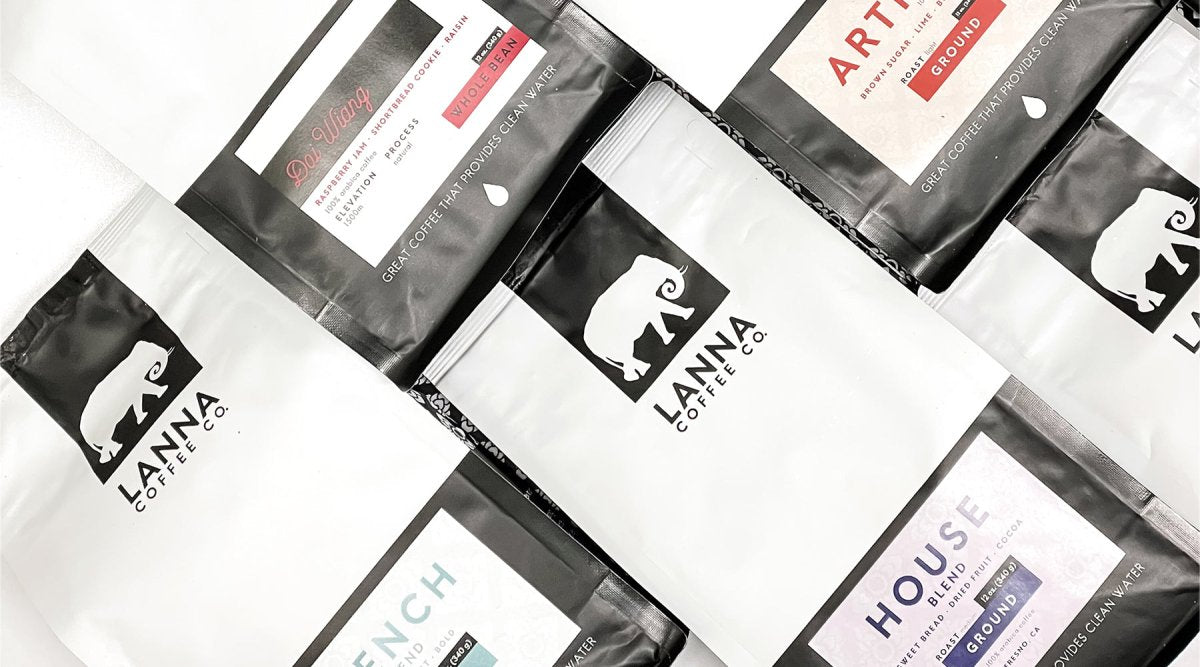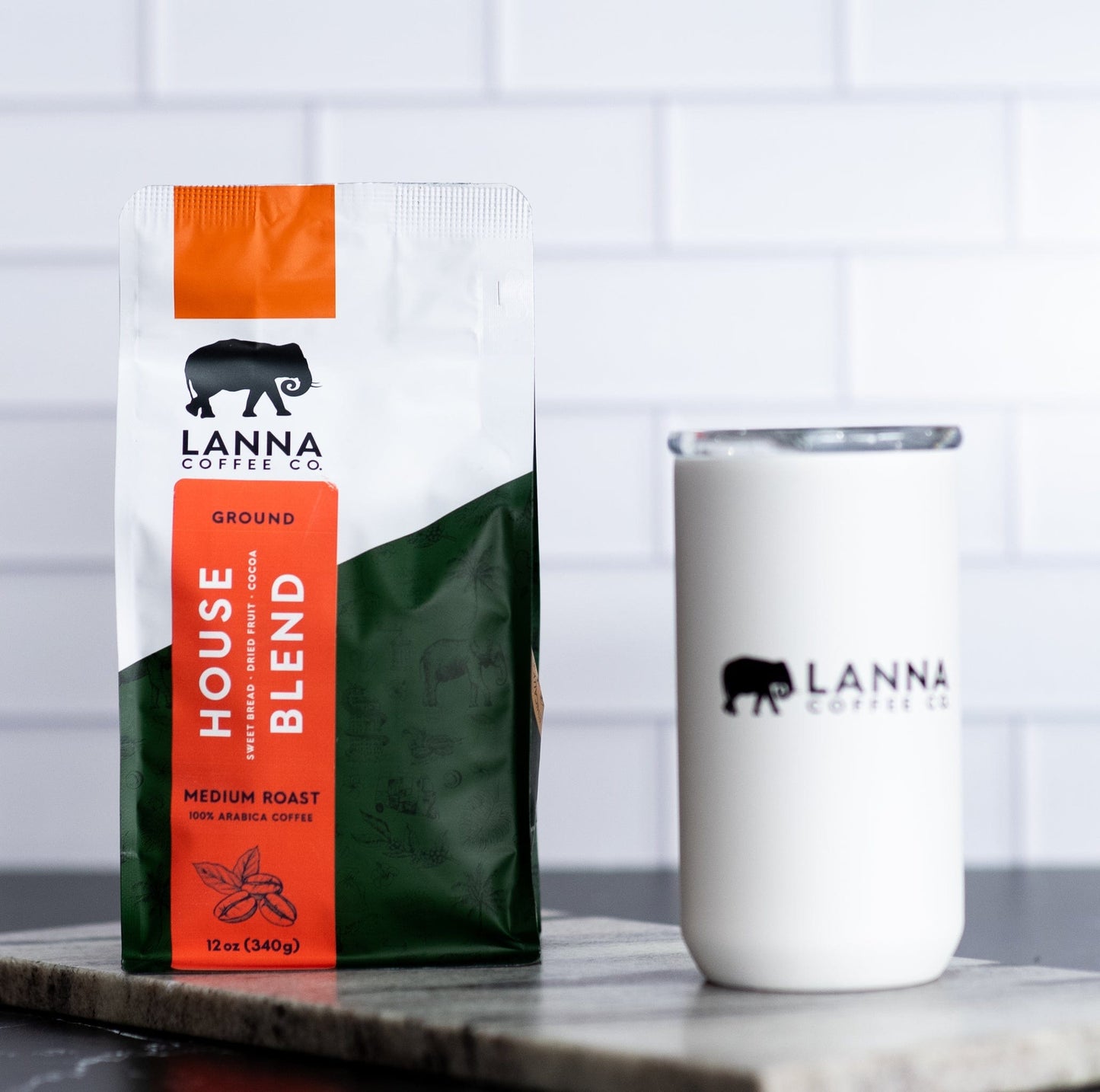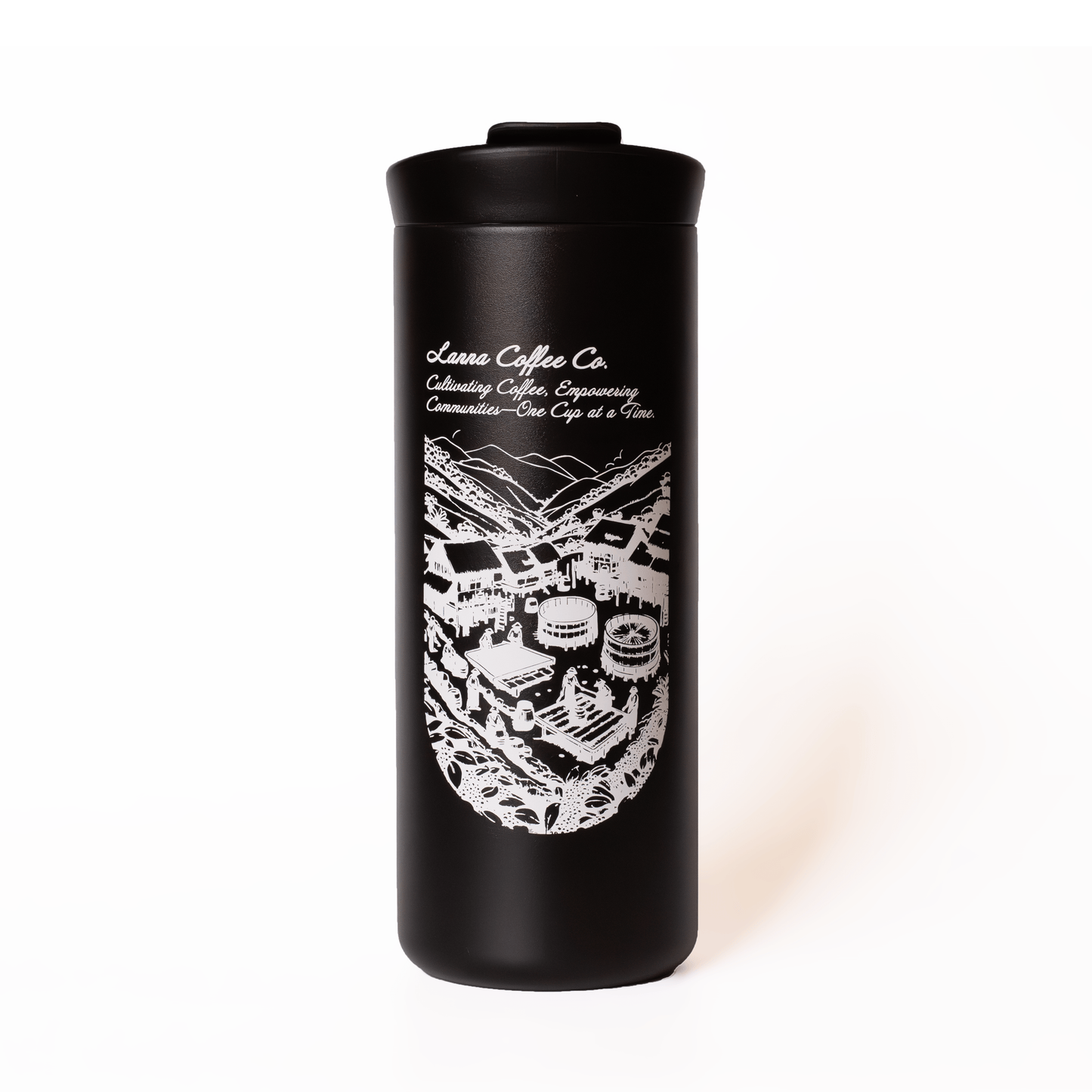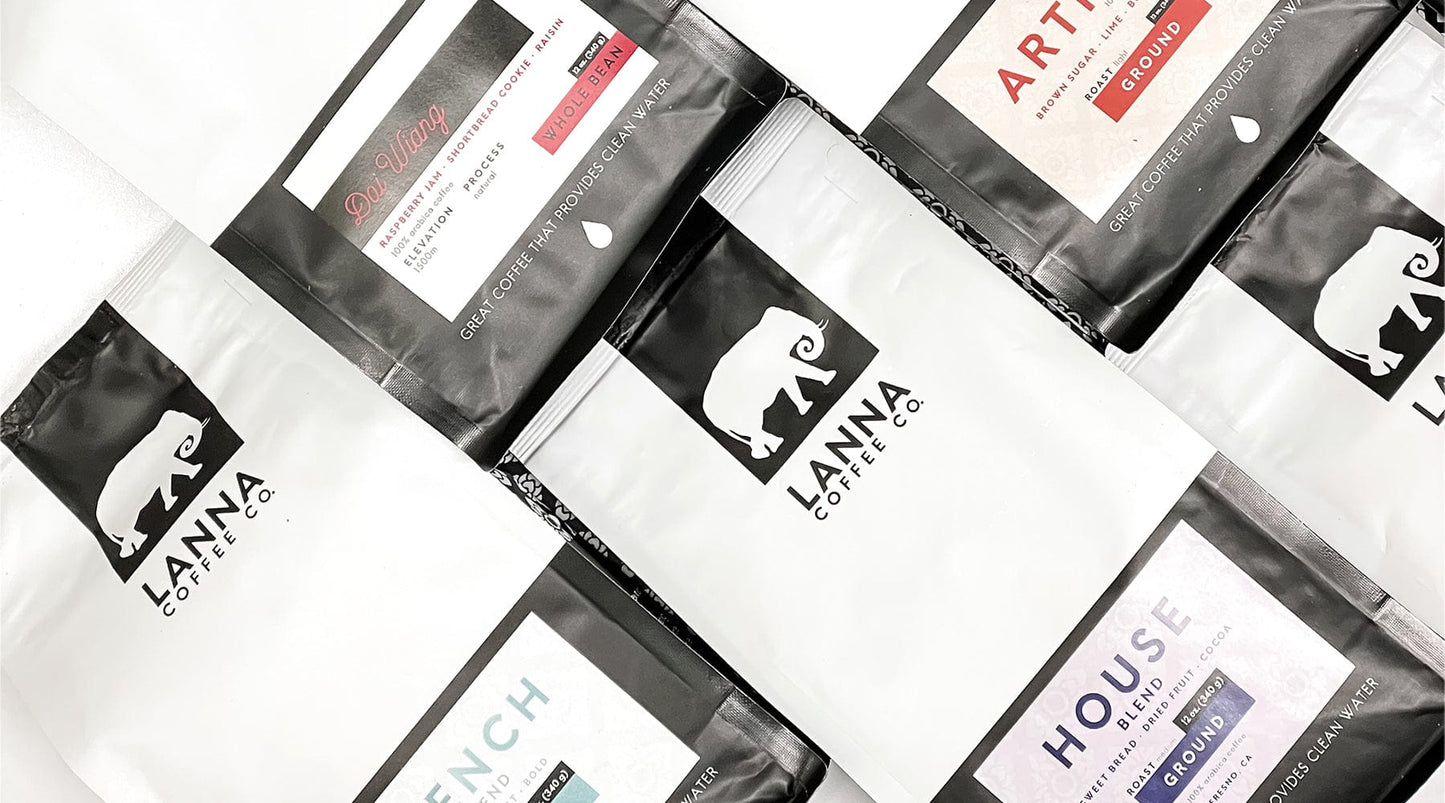
WRITTEN BY: ZOE DUMAS
Whether you’re buying coffee for yourself or a friend, it can be overwhelming trying to pick the right one. Coffee labels are a treasure trove of information as long as you know how to read them, so let’s dive into the words and phrases that will lead you to your next favorite cup.
Understanding the language of a coffee bag really depends on how far you want to go backwards in the coffee’s life cycle. To start simple, just think about how you brew and drink your coffee. Do you like it hot or iced? Black, or with cream and sugar? What roast level do you prefer? Do you enjoy the lighter, more acidic flavor of a light roast, or the malty boldness of a dark roast? Say you want to go further: how was the coffee processed? Where is your coffee coming from. Do you prefer the flavor profiles of, say, an Ethiopian coffee, or maybe something from Colombia? Are you concerned about the social impact of coffee farming? All of these affect the final cup in some way or another and knowing about them will help you choose the right coffee for you and your friends every time.
HOW BREWING AFFECTS YOUR COFFEE'S FLAVOR
Let’s start where many of us start our day: brewing. Both how you brew and how you take your coffee are key components to unearthing your new favorite bag of beans. Most of us brew at home with a drip system, which lends itself quite well to most coffees. Regardless of roast, process, or region, drip is a great way to experience the unadulterated flavors of your coffee. If you’re one of the growing number of home baristas with an espresso machine, medium to dark roast coffees are highly complementary to the process, while lighter roasts tend to have a higher acidity that might make your shot of espresso taste like battery acid.
HOW ROASTING AFFECTS YOUR COFFEE'S FLAVOR
Speaking of, roasting has a profound effect on the way coffee tastes. With an understanding of their coffee’s region, process, and physical makeup, roasters will develop a roast profile complimentary to the flavor compounds they know are likely hidden within that little green bean. Light roasts tend to highlight a coffee’s acidity and fruitiness and have a lighter, more tea-like body. If a coffee is roasted too light, it will come across as very acidic and even a little grassy or peanutty. Medium roasts have less acidity and more bitterness, resulting in a more balanced cup that is sure to please many. These still retain some of the fruity, sugary qualities of a lighter roast, but will often have a caramel quality as well. These feel a little bit heavier on the pallet, but not syrupy. And, finally, dark roasts are the fullest bodied of the bunch. These coffees tend to lean heavily into flavors like dark chocolate, caramel, and spice.
HOW PROCESSING AFFECTS YOUR COFFEE'S FLAVOR
But roasting won’t completely change the flavor of a coffee bean’s chemical makeup: that’s already ingrained in the bean. Certainly, much of this comes from the growing region itself, but process plays a huge part in developing how a coffee will taste. There are three main ways that coffee is processed, with some variation. The oldest of these is the natural process, in which the cascara fruit is laid out in the sun and circulated often. Over time, the fruit will fall away, leaving behind a green coffee that will likely be extra-sugary sweet. This process leaves a lot of room for errors, and sometimes natural coffees will taste overly fermented, even potentially a bit moldy. Because this is the longest, most laborious, and riskiest process, natural coffees often cost a bit more than their more popular counterparts.
On the opposite end of the spectrum are washed coffees. In this process, the cherry is mechanically stripped from the coffee bean. These beans are then placed in clean water, where any remaining fruity flesh is removed via fermentation. After the beans are clean, they are spread out to dry. Washed coffees are considered by many in the coffee industry to be some of the best and most consistent. The wet process is lauded for its ability to produce a complex and clean cup of coffee without any defects that could take away from the drinking experience.
And, in the middle, is the hybrid process. Depending on the region, this can look quite different from one crop to the next. As the name implies, these hybrid processes combine elements of both the natural and washed processes. In the pulped natural and honey process methods, some or all of the fruit is mechanically removed before the coffee beans are laid out to dry as in the natural process. This leaves less room for defects than a fully natural process, but still requires great attention and care. The resulting coffees retain much of the fruity sweetness we expect in naturals while often having complementary caramel or burnt-sugar flavors as well.
HOW LOCATION AFFECTS YOUR COFFEE'S FLAVOR
Process and region are, in many ways, intertwined: the different coffee processes used today are utilized according to the needs present in any given region. But process isn’t the only thing that contributes to a coffee’s flavor. Just like with wine, the physical characteristics of the places coffee is grown impact the final result. Of course, as the world grows closer and techniques are spread from region to region, buying coffee based on region alone won’t always give you the same flavor profiles; however, knowing what has been typical of these regions should at least serve as a good rule of thumb.
Coffee is grown in three regions primarily: Africa, Asia, and the Americas. Coffees from Africa are often fruity and floral, with lots of complex and juicy flavors. Asian coffees tend to exhibit lower levels of acidity and thus are often heavier in body and spicier in taste. Coffees from Central and South America are some of the cleanest and most diverse flavor-wise, with Colombian coffees specifically exhibiting a huge spectrum of flavor possibilities.
There is one final and oft-overlooked aspect of coffee buying: the social component. As you hopefully know by now, coffee takes a lot of work to get from seed to cup, and many farms have a bad history of exploiting the labor of their workers. As we move further away from commodity coffee and towards specialty coffee, it’s important to pay attention to a roaster’s commitment to buying from farms with sustainable practices. Not only will this help you feel better about where your coffee comes from, it can also have a direct impact on the coffee’s quality. When roasters show farms that they are committed to buying specialty coffee produced in places where workers are treated well, those farms can know that their higher labor costs will be rewarded with consistent buyers. As specialty roasters invest in these farms, their product can only improve. Similarly, coffee consumers can demonstrate to their favorite roasters that they, too, prefer this higher-quality coffee, even if it comes with a higher price. When we support and invest in the coffees we love, everyone benefits.
So, now that you know what to pay attention to on a bag of coffee, let’s look at some examples from Lanna’s lineup. Because flavor is probably the biggest deciding factor for a coffee buyer, our recommendations below are organized according to the big five flavor profiles on the SCAA flavor wheel. This, of course, is not the be-all-end-all; coffee is complex, and its flavors mingle to delightful results.
LANNA'S COFFEE BUYING GUIDE
Fruity
The fruitiest of our coffees is our Doi Wiang. The farmers in Doi Wiang use a natural process, and the resulting coffee is roasted light to bring out it’s juicy, fruity flavors. Jammy and sugary, Doi Wiang is a popular choice amongst coffee drinkers looking for something a little bit different than what they may be used to.
Though not as obviously fruit-forward as Doi Wiang, our Artisan blend exhibits pleasant citrus notes in combination with caramel sweetness. Artisan makes a bright, flavorful, and--most importantly--balanced cup of coffee that will liven up anyone’s morning.
Floral
Law Wu is processed with a black-honey process, leaving it about as close to natural as you can get. In this process, most of the fruit is left on the bean before it is put out to dry in the sun. The resulting mucilage will change color as the sugars brown and ferment, thus providing the different colors that we refer to in the honey process. Law Wu is fruity as the process would suggest, but also has floral qualities that balance its syrupy sweetness.
Sweet
If you’re looking for a sugary sweetness reminiscent of caramel and brown sugar with a touch of fruit, Ma Oh Jo is an excellent choice. This washed process coffee has a nice balance of flavors that’s sure to please a wide variety of coffee drinkers.
Similar to Ma Oh Jo, our House blend combines the sweet notes of pastry, chocolate, and dried fruit. Mellow without lacking in complexity, House is a fabulous option for a crowd. If you’re hosting family and friends this Holiday season, you can’t go wrong with this blend.
Nutty/Cocoa
For the nutty/cocoa side of the flavor wheel, we recommend our Sanuk espresso blend. Named for the Thai word for “fun,” Sanuk is a fantastic dark roast that tastes exceptionally great when brewed as espresso. With sweet notes of molasses and cocoa, this coffee is an excellent complement to dairy and sweetener.
If you prefer something even darker and more robust, our French blend is absolutely the way to go. This coffee is deep and earthy, making it especially popular with people who take their morning joe black. French is roasted dark to accentuate flavors like bitter cocoa and pine; it might not be the best to introduce new drinkers to coffee, but long-time fans will definitely appreciate this roast’s boldness.
Spice
With notes of pie crust and baking spice, our Autumn Equinox blend smells like Thanksgiving morning. Combining washed coffees from Thailand and Colombia, Autumn Equinox has a pleasant spice kick that makes it stand out from our year-round offerings. If you haven’t already, be sure to try it before it’s gone.


